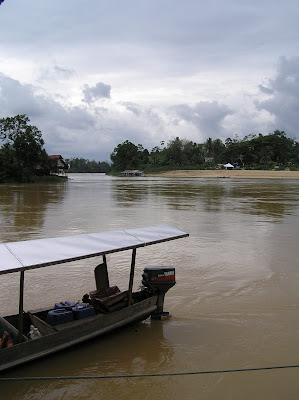Taman Negara : Riverboat
 I haven't explained the main title of this post series yet. Taman Negara means "national forest" in Malaysian. If you ask the locals about taman negara, they will say, "Which one?" If you ask backpackers, they will say, "The jungle?"
I haven't explained the main title of this post series yet. Taman Negara means "national forest" in Malaysian. If you ask the locals about taman negara, they will say, "Which one?" If you ask backpackers, they will say, "The jungle?"Most of the guidebooks (read: Rough Guide and Lonely Planet) refer to the virgin rainforests of West Malaysia as Taman Negara. This is it.
The tour is organised by two competing companies. They include bus fare from Kuala Lumpur's Chinatown to Jerantut. This is a small Chinese town south of the river junction. At the boat dock, you board small, low, locally-built river boats. My jungle guide would later explain these boats are built from a special tree and its sap is used as waterproof sealant in the joints. Due to strong southern currents, the trip lasts about three hours heading north and two hours south. The seat cushion was so thin my legs were numb by the end!
Side note about the expression "small Chinese town": I thought my guidebooks were being politically incorrect when used it to describe towns. Until I visited them. The landscapes in "small Chinese towns" are dominated by Chinese businesses. In the three that I visited, Chinese signs covered about 75% of the town. In other places, it was 25% or less. Many places have had little migration (in or out) over the last fifty years, so their ethnic make-up has barely changed. Many towns were founded outside mines, as the Chinese were used as laborers. After the British left and the republic was formed, many Chinese stayed and continued their families and businesses. Hence today's term: Chinese town.
About the photograph: It confirms beginner's luck and my strategy of over-photographing! (I usually shoot five to twenty shots, rapid-fire, to be safe about lighting and focus.) I was reviewing my fifteen pictures of the boat docking area to select the best for this entry, when I noticed the sky in this photo. If you have ever watched storm chasing documentaries and wondered where you can find similar cloud formations, they are a regular occurrence in Malaysia. A storm may sweep through and last for thirty minutes or less. The gathering and clearing of clouds before and after the storm is an amazing sight.




















